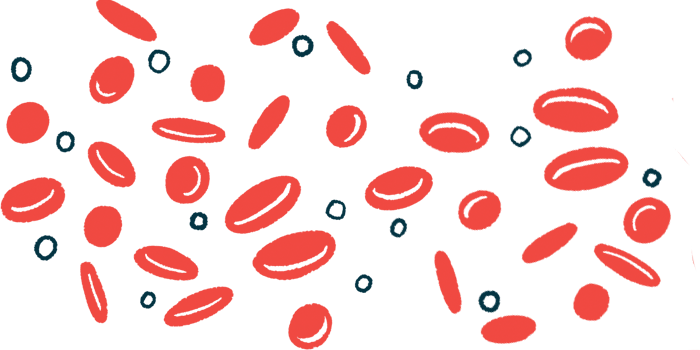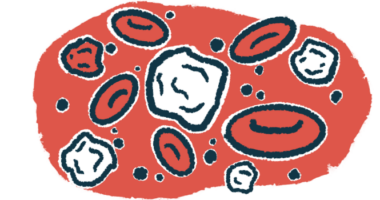Unique immune features found in AIHA may provide drug targets
Scientists say differences support theory that B-cells are key in driving disease

While autoimmune hemolytic anemia (AIHA) — a group of disorders that includes cold agglutinin disease (CAD) — shares some immune features with other red blood cell-targeting diseases, its unique features might help researchers develop targeted therapies, a study reports.
When analyzing the repertoire of immune B- and T-cell receptor proteins (BCRs and TCRs, respectively), the team identified differences between people with AIHA and healthy controls.
These differences primarily occurred in B-cell receptors, supporting the theory that B-cells are crucial for driving AIHA.
AIHA also had distinctive immune receptor patterns when compared with other autoimmune disorders that affect red blood cells.
“Our study showed that … AIHA … patients have specifically skewed BCR and TCR repertoires,” the researchers wrote. “This specific pattern might be a reliable biomarker or even serve as a target for therapeutic approaches.”
The study, “Exploration of B- and T-Cell Receptor Repertoires Reveals Distinct Mechanisms in Pure Red Cell Aplasia, Autoimmune Hemolytic Anemia, and Aplastic Anemia,” was published in the journal Acta Hematologica by two researchers in China.
In AIHA, the immune system wrongly produces self-reactive antibodies that target red blood cells, resulting in their destruction and symptoms like fatigue. The temperature range under which these antibodies bind to red blood cells dictates the type of AIHA.
CAD is the diagnosis when binding occurs at cold temperatures. In warm AIHA, warmer temperatures trigger this process. Mixed forms of AIHA include binding at both cold and warm temperatures.
Analyzing samples from patients with red blood cell-targeting diseases
In all types, B-cells are thought to be the main disease-driving immune component. This is due to their role in antibody production — and to evidence showing that patients typically respond to B-cell-depleting therapies like rituximab (sold as Rituxan and others).
Pure red cell aplasia, called PRCA, and aplastic anemia, known as AA, are two conditions that also involve autoimmune attacks on red blood cells or their precursors. However, the three related conditions “have completely different clinical features and outcomes,” the researchers noted.
A clear description of the different profiles of [B- and T-cell receptor protein] repertoires in patients with these diseases can provide direction for distinguishing these diseases and may provide more accurate targeted therapies for individual diseases.
Scientists don’t yet understand all of the immune processes underlying these differences. Some may be related to BCRs and TCRs. While B-cells produce antibodies, including those that drive autoimmune diseases, T-cells can influence immune responses by regulating the function of other immune cells.
By combining genes in different ways, the immune system can generate many versions of these receptors, each of which specifically recognizes a different antigen, or molecule that produces an immune response.
“A clear description of the different profiles of BCR and TCR repertoires in patients with these [conditions] can provide direction for distinguishing these diseases and may provide more accurate targeted therapies for individual diseases,” the researchers wrote.
With this in mind, the research team analyzed blood samples from 10 people with each of the three conditions — AIHA, PRCA, and AA — and seven healthy controls. All of the AIHA participants had warm AIHA, the most common type.
When compared with control participants, individuals in the three disease groups had some common features, including more antigen stimulation and some distinctive gene activity patterns in BCRs and TCRs.
However, the different disease groups also showed specific gene patterns that may be behind different antigens to which immune cells respond. These patterns may result in the distinct clinical characteristics of each disease, the researchers noted.
“The abnormalities were mainly T-cell related for PRCA patients, B-cell related for AIHA patients and both for AA patients,” the team wrote.
Future drugs could try to target B-cell receptor proteins
People with AIHA had significantly higher activity of the BCR’s IGHV4-31 gene relative to healthy controls, which previously had been “reported to be correlated with autoimmune antibodies secretion,” the researchers wrote.
AIHA was also associated with significantly higher activity of the IGHD6-13 gene in BCRs and the TRBJ1-3 gene in TCRS relative to the other groups.
“Genes expressed [meaning, more active] in the AIHA group were associated with the secretion of autoantibodies,” or self-reactive antibodies, the duo wrote.
Another distinctive feature of AIHA was a higher water-repelling property of a region of the BCR, called CDR3, “indicating increased affinity for the antigen or even increased autoreactivity,” the researchers wrote.
A specific, short sequence of amino acids — the building blocks of proteins — in the CDR3 region, called DFWSG(Y), was also associated with AIHA. If future research confirms that this sequence helps drive immune responses, future therapies could attempt to target this region of the BCR, the scientists noted. Researchers may also be able to develop a blood test for this pattern to help identify AIHA, per the team.
Future research is needed to determine which results also hold for CAD, and to identify unique receptor features in that disease type.
In addition to the exclusion of CAD participants, the study had several limitations. “We explored only a portion of the immune system and focused mainly on BCRs and TCRs,” the researchers wrote. Other parts of the immune system likely also play a role in distinctions between these diseases, the team noted.








